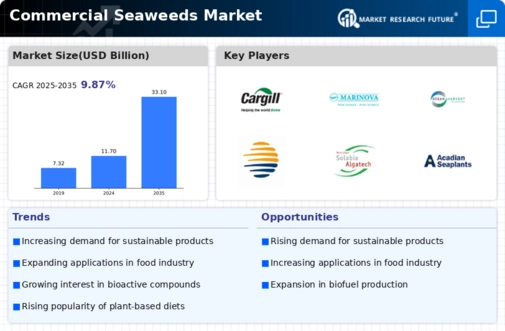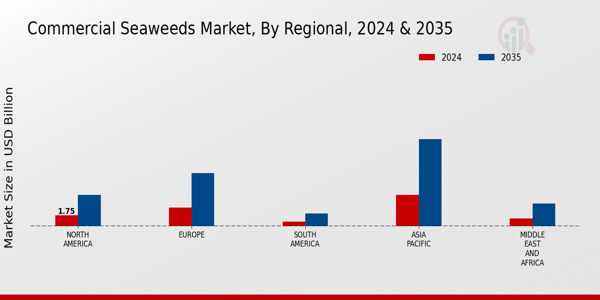Market Growth Projections
The Global Commercial Seaweeds Market Industry is poised for substantial growth, with projections indicating a market value of 11.7 USD Billion in 2024 and an anticipated increase to 33.1 USD Billion by 2035. This growth trajectory reflects a compound annual growth rate of 9.89% from 2025 to 2035. Such figures underscore the increasing recognition of seaweeds as valuable resources across various sectors, including food, agriculture, and pharmaceuticals. The expanding applications of seaweeds, coupled with rising consumer awareness and demand for sustainable products, suggest a robust future for the industry. These projections highlight the potential for investment and innovation within the market.
Sustainable Aquaculture Practices
Sustainability remains a pivotal driver in the Global Commercial Seaweeds Market Industry, particularly as aquaculture practices evolve. Seaweeds are increasingly recognized for their role in sustainable aquaculture, providing essential nutrients and improving water quality. They serve as a natural feed supplement, reducing reliance on fishmeal and promoting environmentally friendly practices. The integration of seaweeds into aquaculture systems not only enhances productivity but also aligns with global sustainability goals. As the industry anticipates a market value of 33.1 USD Billion by 2035, the adoption of sustainable practices is likely to play a crucial role in shaping future growth trajectories.
Health Benefits and Nutritional Value
The health benefits associated with seaweeds significantly influence the Global Commercial Seaweeds Market Industry. Rich in vitamins, minerals, and antioxidants, seaweeds are increasingly incorporated into diets for their potential health advantages, including improved gut health and weight management. The growing awareness of these benefits has led to a rise in seaweed-based products, such as snacks and supplements, appealing to health-conscious consumers. This trend is expected to propel the market forward, with a projected compound annual growth rate of 9.89% from 2025 to 2035. The emphasis on health and wellness continues to drive innovation and product development within the industry.
Rising Demand for Natural Ingredients
The Global Commercial Seaweeds Market Industry experiences a notable surge in demand for natural ingredients across various sectors, including food, cosmetics, and pharmaceuticals. Consumers increasingly prefer products derived from natural sources, leading to a heightened interest in seaweeds, which are rich in nutrients and bioactive compounds. For instance, seaweeds are utilized in food products as thickeners and stabilizers, enhancing texture and flavor. This trend is projected to contribute significantly to the market's growth, with the industry expected to reach 11.7 USD Billion in 2024. The shift towards clean-label products underscores the potential for seaweeds to fulfill consumer preferences for transparency and health benefits.
Technological Advancements in Cultivation
Technological innovations in seaweed cultivation are transforming the Global Commercial Seaweeds Market Industry. Advances in farming techniques, such as vertical farming and integrated multi-trophic aquaculture, enhance yield and efficiency. These methods not only optimize space but also promote biodiversity and ecosystem health. The implementation of technology in cultivation practices is likely to attract investment and support scalability, thereby expanding market reach. As the industry evolves, these advancements may facilitate the production of high-quality seaweeds, catering to diverse applications. This dynamic environment suggests a promising future for the market, aligning with the increasing global demand for sustainable food sources.
Growing Interest in Bioplastics and Biofuels
The Global Commercial Seaweeds Market Industry is witnessing a burgeoning interest in bioplastics and biofuels derived from seaweeds. As environmental concerns regarding plastic waste intensify, seaweeds present a viable alternative for sustainable materials. Bioplastics made from seaweed offer biodegradable options, appealing to eco-conscious consumers and industries. Additionally, seaweeds can be converted into biofuels, providing renewable energy sources that align with global sustainability initiatives. This dual application of seaweeds positions the industry for substantial growth, as the demand for sustainable materials and energy solutions continues to rise. The potential for innovation in this sector may further enhance market dynamics.



















